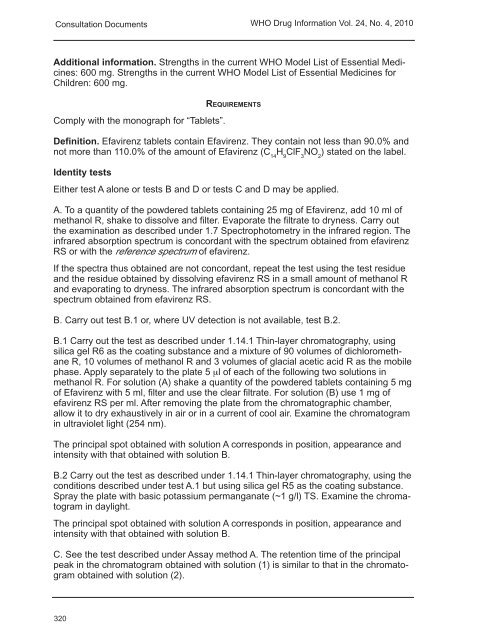WHO Drug Information Vol. 24, No. 4, 2010
WHO Drug Information Vol. 24, No. 4, 2010
WHO Drug Information Vol. 24, No. 4, 2010
You also want an ePaper? Increase the reach of your titles
YUMPU automatically turns print PDFs into web optimized ePapers that Google loves.
Consultation Documents<strong>WHO</strong> <strong>Drug</strong> <strong>Information</strong> <strong>Vol</strong>. <strong>24</strong>, <strong>No</strong>. 4, <strong>2010</strong>Additional information. Strengths in the current <strong>WHO</strong> Model List of Essential Medicines:600 mg. Strengths in the current <strong>WHO</strong> Model List of Essential Medicines forChildren: 600 mg.Comply with the monograph for “Tablets”.REQUIREMENTSDefinition. Efavirenz tablets contain Efavirenz. They contain not less than 90.0% andnot more than 110.0% of the amount of Efavirenz (C 14H 9ClF 3NO 2) stated on the label.Identity testsEither test A alone or tests B and D or tests C and D may be applied.A. To a quantity of the powdered tablets containing 25 mg of Efavirenz, add 10 ml ofmethanol R, shake to dissolve and filter. Evaporate the filtrate to dryness. Carry outthe examination as described under 1.7 Spectrophotometry in the infrared region. Theinfrared absorption spectrum is concordant with the spectrum obtained from efavirenzRS or with the reference spectrum of efavirenz.If the spectra thus obtained are not concordant, repeat the test using the test residueand the residue obtained by dissolving efavirenz RS in a small amount of methanol Rand evaporating to dryness. The infrared absorption spectrum is concordant with thespectrum obtained from efavirenz RS.B. Carry out test B.1 or, where UV detection is not available, test B.2.B.1 Carry out the test as described under 1.14.1 Thin-layer chromatography, usingsilica gel R6 as the coating substance and a mixture of 90 volumes of dichloromethaneR, 10 volumes of methanol R and 3 volumes of glacial acetic acid R as the mobilephase. Apply separately to the plate 5 µl of each of the following two solutions inmethanol R. For solution (A) shake a quantity of the powdered tablets containing 5 mgof Efavirenz with 5 ml, filter and use the clear filtrate. For solution (B) use 1 mg ofefavirenz RS per ml. After removing the plate from the chromatographic chamber,allow it to dry exhaustively in air or in a current of cool air. Examine the chromatogramin ultraviolet light (254 nm).The principal spot obtained with solution A corresponds in position, appearance andintensity with that obtained with solution B.B.2 Carry out the test as described under 1.14.1 Thin-layer chromatography, using theconditions described under test A.1 but using silica gel R5 as the coating substance.Spray the plate with basic potassium permanganate (~1 g/l) TS. Examine the chromatogramin daylight.The principal spot obtained with solution A corresponds in position, appearance andintensity with that obtained with solution B.C. See the test described under Assay method A. The retention time of the principalpeak in the chromatogram obtained with solution (1) is similar to that in the chromatogramobtained with solution (2).320

















